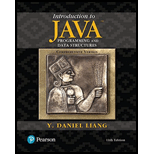
Introduction to Java Programming and Data Structures, Comprehensive Version (11th Edition)
11th Edition
ISBN: 9780134670942
Author: Y. Daniel Liang
Publisher: PEARSON
expand_more
expand_more
format_list_bulleted
Concept explainers
Question
Chapter 27.6, Problem 27.6.1CP
Program Plan Intro
Open Addressing:
- Open Addressing is a method of finding an open location in the hash table at the time of collision.
- There are several variations for open addressing such as linear probing, quadratic probing, and double hashing.
Linear Probing:
- Linear probing is one of the variations of open addressing.
- When an entry is inserted into a hash table, a collision occurs. At the time of collision, linear probing will start finding the next available location sequentially.
- Linear probing will look at the consecutive cells which begin at index k.
- Starting from the initial index, linear probing will add an increment of 1 to k to define a search sequence.
Expert Solution & Answer
Want to see the full answer?
Check out a sample textbook solution
Students have asked these similar questions
show all the work
answer question 3
Show the work
Chapter 27 Solutions
Introduction to Java Programming and Data Structures, Comprehensive Version (11th Edition)
Ch. 27.2 - Prob. 27.2.1CPCh. 27.3 - Prob. 27.3.1CPCh. 27.3 - Prob. 27.3.2CPCh. 27.3 - Prob. 27.3.3CPCh. 27.3 - Prob. 27.3.4CPCh. 27.3 - Prob. 27.3.5CPCh. 27.3 - Prob. 27.3.6CPCh. 27.3 - If N is an integer power of the power of 2, is N /...Ch. 27.3 - Prob. 27.3.8CPCh. 27.3 - Prob. 27.3.9CP
Ch. 27.4 - Prob. 27.4.1CPCh. 27.4 - Prob. 27.4.2CPCh. 27.4 - Prob. 27.4.3CPCh. 27.4 - Prob. 27.4.4CPCh. 27.4 - Prob. 27.4.5CPCh. 27.4 - Prob. 27.4.6CPCh. 27.5 - Prob. 27.5.1CPCh. 27.6 - Prob. 27.6.1CPCh. 27.6 - Prob. 27.6.2CPCh. 27.6 - Prob. 27.6.3CPCh. 27.7 - Prob. 27.7.1CPCh. 27.7 - What are the integers resulted from 32 1, 32 2,...Ch. 27.7 - Prob. 27.7.3CPCh. 27.7 - Describe how the put(key, value) method is...Ch. 27.7 - Prob. 27.7.5CPCh. 27.7 - Show the output of the following code:...Ch. 27.7 - If x is a negative int value, will x (N 1) be...Ch. 27.8 - Prob. 27.8.1CPCh. 27.8 - Prob. 27.8.2CPCh. 27.8 - Can lines 100103 in Listing 27.4 be removed?Ch. 27.8 - Prob. 27.8.4CPCh. 27 - Prob. 27.1PECh. 27 - Prob. 27.2PECh. 27 - (Modify MyHashMap with duplicate keys) Modify...Ch. 27 - Prob. 27.6PECh. 27 - Prob. 27.7PECh. 27 - Prob. 27.8PECh. 27 - Prob. 27.10PECh. 27 - Prob. 27.11PECh. 27 - (setToList) Write the following method that...Ch. 27 - (The Date class) Design a class named Date that...Ch. 27 - (The Point class) Design a class named Point that...
Knowledge Booster
Learn more about
Need a deep-dive on the concept behind this application? Look no further. Learn more about this topic, computer-science and related others by exploring similar questions and additional content below.Similar questions
- Capsim Team PowerPoint Presentations - Slide Title: Key LearningsWhat were the key learnings that you discovered as a team through your Capsim simulation?arrow_forwardWrite the SQL code that permits to implement the tables: Student and Transcript. NB: Add the constraints on the attributes – keys and other.arrow_forwardDraw an ERD that will involve the entity types: Professor, Student, Department and Course. Be sure to add relationship types, key attributes, attributes and multiplicity on the ERD.arrow_forward
- Draw an ERD that represents a book in a library system. Be sure to add relationship types, key attributes, attributes and multiplicity on the ERD.arrow_forward2:21 m Ο 21% AlmaNet WE ARE HIRING Experienced Freshers Salesforce Platform Developer APPLY NOW SEND YOUR CV: Email: hr.almanet@gmail.com Contact: +91 6264643660 Visit: www.almanet.in Locations: India, USA, UK, Vietnam (Remote & Hybrid Options Available)arrow_forwardProvide a detailed explanation of the architecture on the diagramarrow_forward
- hello please explain the architecture in the diagram below. thanks youarrow_forwardComplete the JavaScript function addPixels () to calculate the sum of pixelAmount and the given element's cssProperty value, and return the new "px" value. Ex: If helloElem's width is 150px, then calling addPixels (hello Elem, "width", 50) should return 150px + 50px = "200px". SHOW EXPECTED HTML JavaScript 1 function addPixels (element, cssProperty, pixelAmount) { 2 3 /* Your solution goes here *1 4 } 5 6 const helloElem = document.querySelector("# helloMessage"); 7 const newVal = addPixels (helloElem, "width", 50); 8 helloElem.style.setProperty("width", newVal); [arrow_forwardSolve in MATLABarrow_forward
arrow_back_ios
SEE MORE QUESTIONS
arrow_forward_ios
Recommended textbooks for you
 C++ Programming: From Problem Analysis to Program...Computer ScienceISBN:9781337102087Author:D. S. MalikPublisher:Cengage Learning
C++ Programming: From Problem Analysis to Program...Computer ScienceISBN:9781337102087Author:D. S. MalikPublisher:Cengage Learning Programming Logic & Design ComprehensiveComputer ScienceISBN:9781337669405Author:FARRELLPublisher:Cengage
Programming Logic & Design ComprehensiveComputer ScienceISBN:9781337669405Author:FARRELLPublisher:Cengage New Perspectives on HTML5, CSS3, and JavaScriptComputer ScienceISBN:9781305503922Author:Patrick M. CareyPublisher:Cengage Learning
New Perspectives on HTML5, CSS3, and JavaScriptComputer ScienceISBN:9781305503922Author:Patrick M. CareyPublisher:Cengage Learning Systems ArchitectureComputer ScienceISBN:9781305080195Author:Stephen D. BurdPublisher:Cengage LearningNp Ms Office 365/Excel 2016 I NtermedComputer ScienceISBN:9781337508841Author:CareyPublisher:Cengage
Systems ArchitectureComputer ScienceISBN:9781305080195Author:Stephen D. BurdPublisher:Cengage LearningNp Ms Office 365/Excel 2016 I NtermedComputer ScienceISBN:9781337508841Author:CareyPublisher:Cengage

C++ Programming: From Problem Analysis to Program...
Computer Science
ISBN:9781337102087
Author:D. S. Malik
Publisher:Cengage Learning


Programming Logic & Design Comprehensive
Computer Science
ISBN:9781337669405
Author:FARRELL
Publisher:Cengage

New Perspectives on HTML5, CSS3, and JavaScript
Computer Science
ISBN:9781305503922
Author:Patrick M. Carey
Publisher:Cengage Learning

Systems Architecture
Computer Science
ISBN:9781305080195
Author:Stephen D. Burd
Publisher:Cengage Learning

Np Ms Office 365/Excel 2016 I Ntermed
Computer Science
ISBN:9781337508841
Author:Carey
Publisher:Cengage